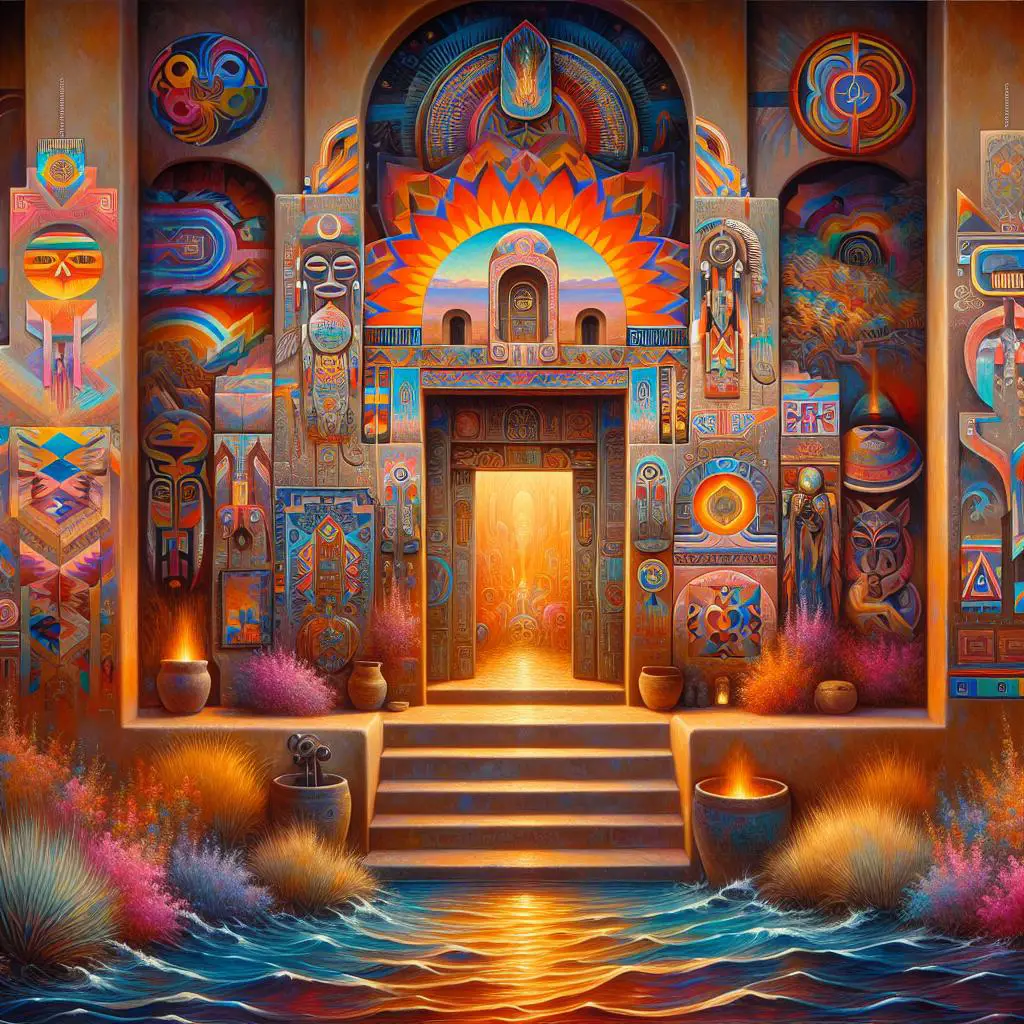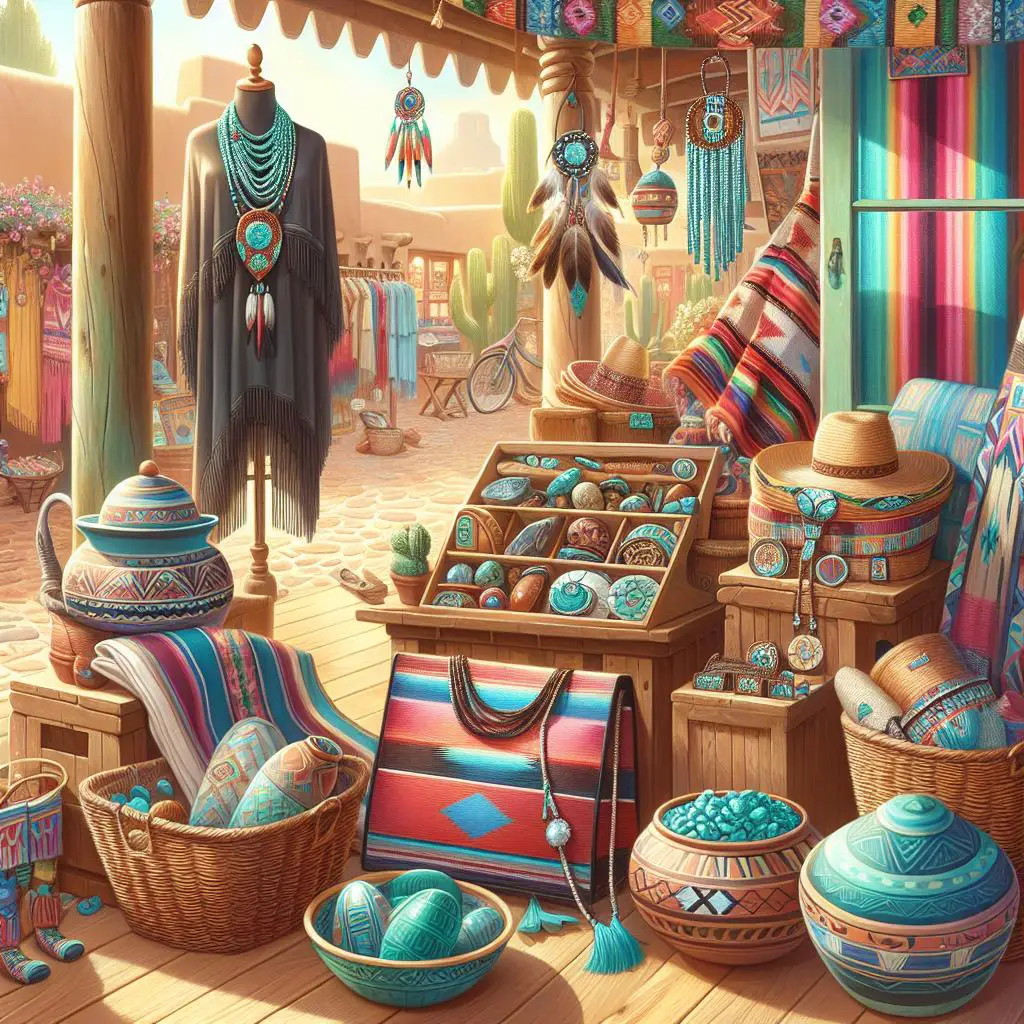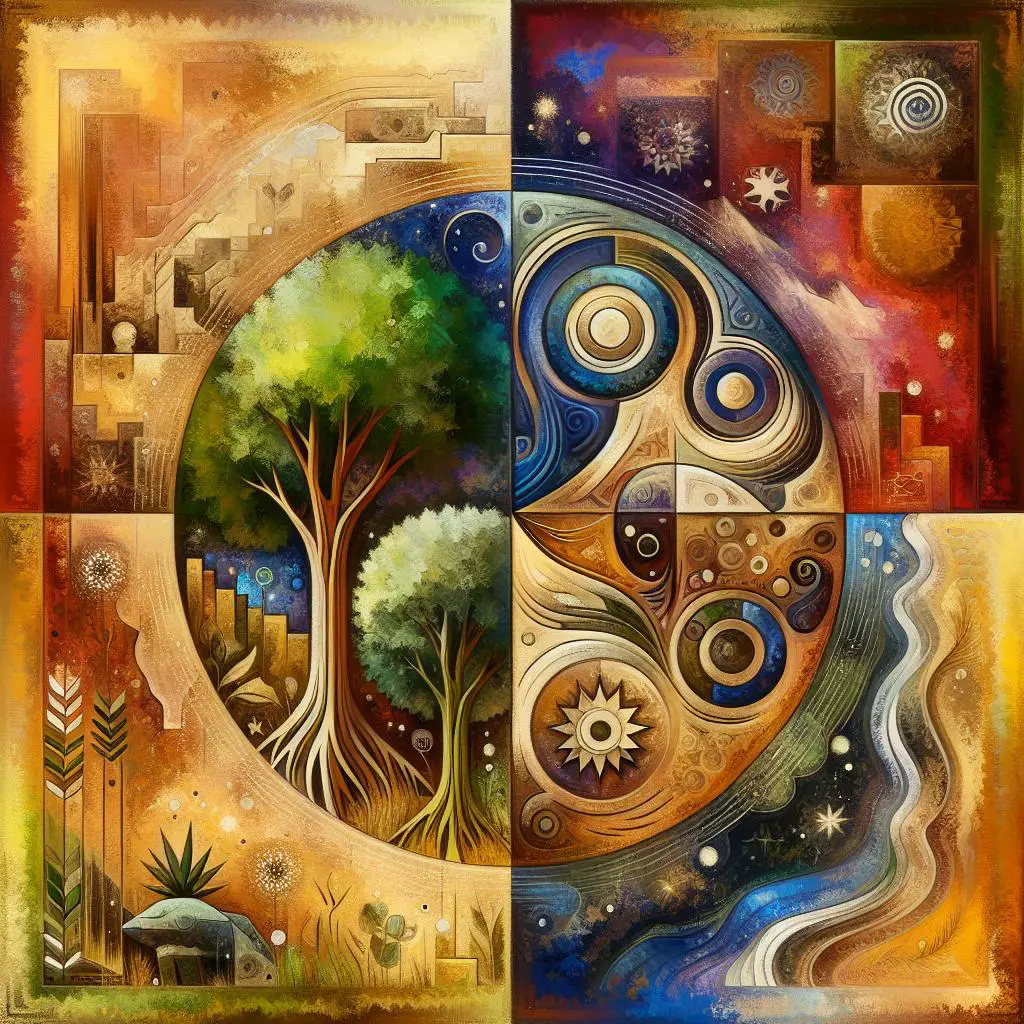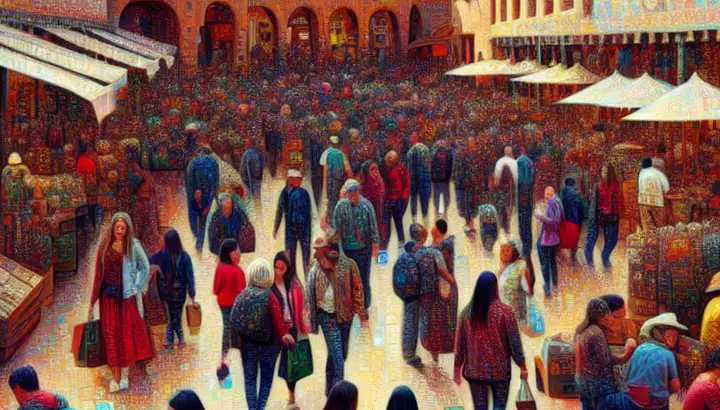Contemporary Southwestern Art Movements

1. Role of spirituality in Contemporary Southwestern Art
Title: “Chiles, Peyote and Spirituality: A Cheeky Stroll through Contemporary Southwestern Art”
Welcome, esteemed art enthusiasts, curious dilettantes, and accidental WiFi surfers who furiously mistyped “Southwest Airlines”! Buckle in for a whimsical, prickly-pear-inspired journey through the vibrant and soulful realm of contemporary Southwestern art – a world where psychedelic cacti dance under blazing sunsets and shamanistic kokopelli play their flutes to the coyotes’ nocturnal serenades.
Now, art, like a pepper-laced margarita, can be sharp, surprising, and mysterious to the unversed. So, allow me to sketch out the significance of spirituality in the ever-evolving canvas of contemporary Southwestern art.
Picture, if you will, a desert: A swirling inferno of sepia-toned sands where mystical saguaros grow like cathedral spires. A land where the sun kisses the earth daily with a fire so fierce, it burns the very colors into existence. This is the treasured yet harsh environment that has cradled Southwestern art, etching spiritual manifestations into it with the relentless intensity of a desert wind.
The contemporary style, with its unique blend of Native American, Hispanic, and Anglo influences, explores the spiritual aspects of life in captivating imagery. Art in this terrain is a heart-wrenching saga of hundreds of years of trading, cultural assimilation, and turbulent history, sprinkled with a delicate dusting of spiritual insights.
From the sacred geometry incarnate in the breathtaking Hopi kachina dolls to the intricate spirits and saints personified in the Spanish colonial retablos, the essence of Southwestern art is imbued with an aura of existential curiosity. This curiosity seeks, pokes, prods, and explores the very soul of existence. Recently, many artists have used their works to champion the protection of nature, reflecting ancestral beliefs of honoring and respecting Mother Earth’s resources– sort of like a judicious grandma stewarding her Christmas dinner leftovers, but with a whole lot more firepower behind it.
Previous centuries’ religious fervor has softened into a spiritual whisper in contemporary works, meshing the mystical, the practical, and sometimes the downright surreal. Modern interpretations of the Kokopelli fertility deity, for example, are touched with humor and playful spirit, akin to a cheeky, mischievous cousin strumming a tune at a family gathering, subtly reminding us of the web of life in which we are all woven.
“THE RELIGIOUS PERIOD, 273 THE TWO CAUSES OF THE RISE OF RELIGIOUS FEELING, 273 THE NEED OF SPIRITUAL AUTHORITY, 275 THE RISE OF THE CONCEPTION OF SPIRITUALITY, 277 THE REVIVAL OF PLATONISM, 279 THE DIVISIONS OF THE RELIGIOUS PERIOD, 280 THE HELLENIC RELIGIOUS PHILOSOPHIES, 282 THE INTRODUCTORY PERIOD OF HELLENIC RELIGIOUS PHILOSOPHY”
~ Unknown, Unknown
Arizona artist Amado Peña Jr. masterfully embraces this fusion of ancient spiritual tradition and modern social commentary, playing the notes of tradition and innovation like a virtuoso on a painted violin.
Contemporary Southwestern art dances the rumba of resilience, the waltz of wisdom and the Cha-Cha of cultural heritage on its vibrant canvas of spirituality. It plays coy with the beholder, like flirting lovers under a mesa moonlight, hinting at spiritual secrets or simply asking us to laugh at our human foibles.
In conclusion, spirituality’s role in Contemporary Southwestern Art is much like the elusive jackrabbit in the desert – it leaps, dodges, and scuttles across the canvas, leaving behind an arresting trail of colored beauty and authentic wisdom. It invites you, the viewer, to tap into your intuition, be present and perceive art as a spiritual experience. Whether that experience feels as potent as a swig of tequila or as gentle as a Santa-Fe sunset, the essence remains – it’s a celebration of life, connecting us with something beyond the mere physical.
In the meantime, happy art viewing, my friends. And remember, always pack sunscreen – even in the metaphoric desert of a canvas.
Learn More Here: 1. Role Of Spirituality In Contemporary Southwestern Art

2. The influence of Indigenous cultural aesthetics
As the sun sets on another day, let’s delve into the fascinating, vibrant, and awe-inspiringly beautiful world of indigenous cultural aesthetics. The rainbow of colors, intricate patterns, bold designs, and deeply rooted values that make up indigenous cultures are not just a smorgasbord delight for the artist’s heart but a rich and fertile soil from which grows a profound sense of identity and belonging.
The influence of indigenous cultural aesthetics extends far beyond what the naked eye can see, concocting a dazzling cocktail of art, design, fashion, and even architecture. It’s a rich meandering river, sometimes painting skyscrapers, sometimes tattooing skins, and other times bedecking canvases.
Take a stroll anywhere around the globe, and you’ll find sassy footprints of indigenous aesthetics. In the Americas, from the exuberant color palettes of Native American beadwork to the moody hues of Inuit art, these aesthetics have seeped into mainstream fashion and arts, breaking conventional norms and sparking the kind of creativity that leaves an haute couture fashion designer screaming “Eureka!” in the shower.
Africa, the tumultuous and vibrant cradle of humanity, offers an aesthetic so unique and potent, it’s like Picasso and Beyoncé had a baby, and this baby decided to redecorate the world. Kente cloth of Ghana, Maasai beadwork from Kenya, or the Benin bronze sculptures of Nigeria, Africa’s aesthetic influence is pervasive, adding color, texture, and a dash of panache to the world of fashion, home décor, and arts.
Down Under in Australia, the Aboriginal art has a 60,000-year-old lineage and serves as the planet’s most ancient unbroken art tradition. Makeup brands siphon inspiration from its dreamy, antediluvian aesthetics, and bedroom walls across the globe are adorned with the captivating ochre swirls and dots of Aboriginal art.
Indigenous aesthetics are not just about the eyes; it’s about the soul and the shared human experience. The aesthetic values distilled in indigenous culture carry strong elements of community cohesion and respect for the environment.
“Alexandria, while a cosmopolitan city in the inhabitants who dwelt in it and in the wide diffusion of commercial interests that centred there as a mart for East and West, was absolutely ruled by Greeks and represents for many centuries after {66} the decline of Athens had come, the brightest focus of Greek intellectual life, Greek culture and art, Greek letters and education and every phase of that Greek influence in aesthetics which has always meant so much in the world’s history”
~ James J. Walsh, Education: How Old The New
They carry messages of history, survival, resistance, and resilience, piercing through our shared humanity and averting the catastrophe of a monochrome culture monolith.
Humorously enough, these aesthetics often find themselves in the hands of naïve hipsters wearing a tribal feather headdress to a music festival or TikTokers donning Maori-inspired tattoos without realizing their sacred significance. Of course, all done with no malice, but highlight the need for better cross-cultural understanding. As a wise man once said, “You have two ears and one mouth for a reason. Listen more!”
The truth is, just like a spicy Thanksgiving turkey, the influence of indigenous cultural aesthetics spices up our world and infuses it with a rich, diverse flavor, a flavor that tells stories of generations and transforms the ordinary into extraordinary.
In a world that is continuously shrinking into a global village, indigenous aesthetics remind us of our roots and enrich our understanding – and appreciation – of cultural diversity.
So, the next time you spot a dashiki at a local market or marvel at the mandala-like symmetry of a Navajo rug, remember, you’re not just appreciating a pretty design; you’re witnessing the resilience of culture, the power of storytelling, and the enchanting dance of aesthetics, crafted lovingly, sometimes stubbornly, by our ancestors on this beautiful sphere we call home. A dance that twirls us into a happening, diverse, and sparkly world. Isn’t that simply fantastic?
Read More Here: 2. The Influence Of Indigenous Cultural Aesthetics

3. Eco-conscious themes in Southwestern art movements
As we journey along the rainbow-dusted art highways of the Southwest, the cacti loom like green paint strokes against a cerulean sky, and you know you’re not in Kansas anymore, Toto. But aside from the iconic vistas, Arizona chili bowls, and questionable novelty roadrunner souvenirs, there’s something remarkable stirring in this aria of arid Arizona; Earth-friendly art movements that are challenging the status quo, right here in what John Wayne would call, “the wild frontier”. Welcome aboard the eco-conscious wagon, folks. Buckle up!
The first of three jaw-dropping southwestern art movements is the trendy upcycling of, well, junk. In an artist’s world, one man’s trash is quite literally another man’s treasure. In backyards and basements from Santa Fe to Flagstaff, artists are reaching elbow-deep into refuse bins to pull out their next masterpiece material. You might say it’s like a very sophisticated blend of dumpster diving and pin-the-tail-on-the-donkey. A bicycle discard reshaped into a vibrant garden sculpture? The raw industrial charm of a wine barrel transformed into a rustic coffee table? Right here in this corner of the country, the discarded everyday artifacts are being brought back to life with more pizazz than a sequin-studded Elvis impersonator at a Vegas Bingo night.
Secondly, there’s the eco-mural movement. Knowing southwestern artists, you’d think murals would be painted with a twanging banjo soundtrack under a scorching sun, but the reality is even more amazing. Murals utilize an entire building as a canvas and concoct a larger-than-life narrative, bringing local culture, history, and nature to striking life. What’s even more impressive is that these larger than a cowboy’s appetite size paintings are being created using eco-friendly paints.
“Then the Cardinal slackened his speed, and began to talk of matters quite different; of the brilliant African campaign; of the likelihood of Muley Hassan holding his own, now he was reinstated; of the probable movements of Barbarossa; of the glut of Moorish slaves in the market, and so forth”
~ Anne Manning, The Duchess of Trajetto
That’s right, folks: no more inhaling those pesky toxins! And for bonus points, many of these murals are laid over with solar-resistant coatings that prevent fading, making your beautiful work last longer than a Route 66 traveller’s tan.
Finally, we’re hiking up the trail to the pinnacle of eco-conscious themes in southwestern art, the use of natural resources. Some artists might stroke their goatees and ponder in 50 shades of angst over the perfect shade of Prussian blue. Not southwestern artists, no siree! Here Mother Nature herself stocks the art supply store. Think sustainable stone-carved sculptures and sand canvases that put regular canvases out of work, as well as stunning pottery molded from the very clay of the earth, painted with traditional pigments derived from plants. Art doesn’t get more wholesome than that unless it could hand you a glass of fresh lemonade while humming ‘Sweet Home Alabama’.
So there you have it folks, a wild and whimsical tour through the eco-conscious themes reigning supreme in the southwestern art scene. It’s a world where garbage becomes gallery-grade, where murals have a green heart, and where Earth herself plays muse. While the eco-friendly badges these movements wear won’t save a stranded desert tortoise from a tumbleweed tornado, they’re carving out a grand land ethic and showing the world that art doesn’t have to cost the earth, quite literally. And so, we tip our sombreros to these trailblazing artists, leaving us with one lingering question: How on Earth do we get all this sand out of our boots?
Read More Here: 3. Eco-conscious Themes In Southwestern Art Movements
